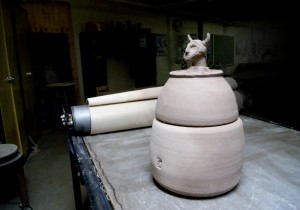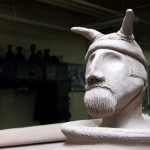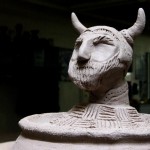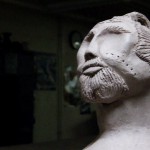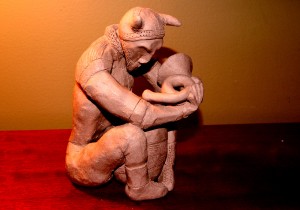 This is what happens when there is leftover saggar clay and I’m sitting around over the holidays watching too many movies. Due to the groggy composition of this particular clay, it isn’t the sort of medium that would find its way into a ceramic musical instrument, so, this lump became my first, stand alone, kiln god. And yes, there are similarities to the busts that top the lids of my latest saggar projects (shocking, eh?).
This is what happens when there is leftover saggar clay and I’m sitting around over the holidays watching too many movies. Due to the groggy composition of this particular clay, it isn’t the sort of medium that would find its way into a ceramic musical instrument, so, this lump became my first, stand alone, kiln god. And yes, there are similarities to the busts that top the lids of my latest saggar projects (shocking, eh?).
Leif, Guardian of MugPhlutes and Ceramic Musical Instruments, will take his place above the door of the gas kiln next month after a bisque firing. The tradition of kiln gods among potters is probably a hold over from an early civilization that believed in animism and polytheistic worship…not so for me, this is just a(nother) touch of whimsy. Leif began as an anatomically correct Nordic nude wearing nothing but his horned helmet. Since December has had its snowy-cold days, Leif sprouted some semblance of cover. We couldn’t have Leif’s parts freezing (or burning) off, now could we!?
Leif’s story?: Prized horns of victory, like the one he clutches here, deserve attention and protection during their construction and firing. Leif has wrapped himself around a cauldron of fire, passing his spiritual powers on the instrument before placing it into the tempering flames. (That’s the best I can do on short notice).
Leif stands (or sits in this instance) roughly 8″ in height. The larger portions of the head, body, and legs are hollowed out. The caldron (urn) between Leif’s legs is a 3″ tall pinch-pot.
